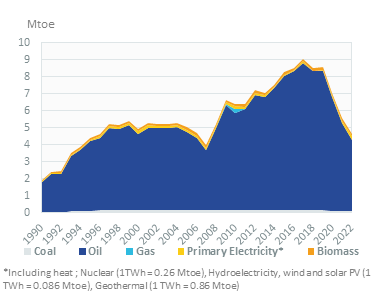-
-
 Energy and Climate Databases
Energy and Climate Databases- The most comprehensive and up-to-date annual energy database.
- Monitoring of technology providers in H2 supply chain.
- Monthly energy data on key energy markets.
- The most reliable and up-to-date power generation database.
- The essentials of LNG trade at your fingertips.
- Global monitoring of new and existing refineries.
- Analyse energy consumption and efficiency trends at world level. Benchmark countries.
- Have your database developed by a recognised expert of both energy and IT.
-
 Energy - Climate Forecasts
Energy - Climate Forecasts- Instant access to energy and emissions forecasts.
- Strategic, annual wholesale price projections backed by Enerdata's energy modelling expertise and our globally recognised POLES model.
- Wedges module showing a breakdown of the levers enabling to reduce emissions between two scenarios.
- Unique, independent projections of consumption by end-use.
- GHG Marginal Abatement Cost Curves.
- Benefit from proven models to draw your own energy scenarios and anticipate tomorrow’s challenges.
-
 Market Intelligence
Market Intelligence- 110 Energy and climate country reports
- A newsletter to receive the latest updates on evolving technologies and policies.
- Global energy news and analyses curated daily.
- Enerdata’s experts bring you the essentials about your market and competitors.
-
-
-
 Market Analysis
Market Analysis- Understanding key consumption trends and drivers across sectors.
- Granular and exclusive insight to address the most pressing business and strategic issues.
- Expertise in strategic and business intelligence, with fine-tuning to the market’s specificities.
-
 Energy - Climate Scenarios
Energy - Climate Scenarios- Providing the outlook of an energy commodity in mid to long term time horizons.
- Sector and driver specific energy demand forecasting.
- Assess the evolution of energy prices on the international and regional markets, as well as end-users prices.
- Enerdata guides you through pathways to reach climate targets.
- Supporting local authorities in their decarbonisation strategies.
-
 Climate Strategy and Policy Evaluation
Climate Strategy and Policy Evaluation- Cutting-edge quantitative tools and relevant indicators to monitor and evaluate evolutions on worldwide energy markets.
- Analysis of the most cost-effective options to reduce emissions.
- Quantified simulation and analysis of pledges for climate change negotiations.
- Breakdown and analysis of carbon markets.
- Enerdata guides you on the most beneficial policy or investment options.
- Turning climate objectives into concrete action plans.
-
 Training
Training- Understand different policy targets and measures on energy efficiency.
- How to measure energy savings?
- Energy Forecasting is a 2 days training to learn to design and interpret energy forecasts.
- Energy statistics training allowing to create energy balance with supply, transformation and consumption and understanding the international energy statistics regulations.
- Initiation to EnerMED level 1is the training to approach on the most powerful energy demand forecasting model.
-
-
Resource Centre
Lebanon Key Figures
- Population:
- 5.49 million
- GDP growth rate:
- -5.4 %/year
- Energy independence:
- 6.76%
Data of the last year available: 2022
- Total consumption/GDP:*
- 90.2 (2005=100)
- CO2 Emissions:
- 2.38 tCO2/capita
- Rate of T&D power losses:
- 9.87%
* at purchasing power parity
View all macro and energy indicators in the Lebanon energy report
Lebanon Related News
View all news, archive your new and create your own daily newsletters only on your topics/countries of interest with Key Energy Intelligence
Lebanon Related Research
Benefit from up to 2 000 up-to-date data series for 186 countries in Global Energy & CO2 data
A data overview is available in the global energy statistics app
Total Energy Consumption
Per capita energy consumption was 0.9 toe/cap in 2022 (i.e. 73% below the Middle East average) and per capita electricity consumption nearly 1 600 kWh (62% lower than in the region).
Total energy consumption has halved since 2017, including -16% in 2022 to 4.7 Mtoe. It previously increased rapidly between 2010 and 2017 (around 5%/year).
Graph: CONSUMPTION TRENDS BY ENERGY SOURCE (Mtoe)

Interactive Chart Lebanon Total Energy Consumption
Benefit from up to 2 000 up-to-date data series for 186 countries in Global Energy & CO2 data
View the detailed fondamentals of the market at country level (graphs, tables, analysis) in the Lebanon energy report
Crude Oil Production
Lebanon does not produce oil and has no refining capacity. The country's two refineries (Tripoli and Zahrani) were both closed in 2005.
The country imported 4.1 Mt of oil product in 2022 (after a peak of 8.5 Mt in 2017). In 2022, imports mainly came from Greece (33%), followed by Turkey (24%) and Italy (10%).
Interactive Chart Lebanon Crude Oil Production
Benefit from up to 2 000 up-to-date data series for 186 countries in Global Energy & CO2 data
Additionally, for more detailed information on refineries, you can request a sample of our EMEA Refineries Dataset
Renewable in % Electricity Production
In its updated NDC (2021), Lebanon pledged to unconditionally generate 18% of its power demand and 11% of its heat demand (in the building sector) from renewables in 2030. These renewable targets could conditionally be increased to 30% of its power demand and to 16.5% for heat with international support.
Interactive Chart Lebanon Share of Renewables in Electricity Production (incl hydro)
Benefit from up to 2 000 up-to-date data series for 186 countries in Global Energy & CO2 data
CO2 Fuel Combustion/CO2 Emissions
According to its updated NDC (2021), the country intends to unconditionally reduce its GHG emissions by 20% by 2030 compared to a BAU scenario (conditional reduction of 31% by 2030).
CO2 emissions from energy combustion have halved since 2017, from 27 Mt to 13 Mt in 2022, with an 18% fall in 2022, mainly due to the drop in demand following the global economic shock. Previously, they had more than doubled between 2007 and 2017 (+7.7%/year).
Graph: CO2-ENERGY EMISSIONS (MtCO2)